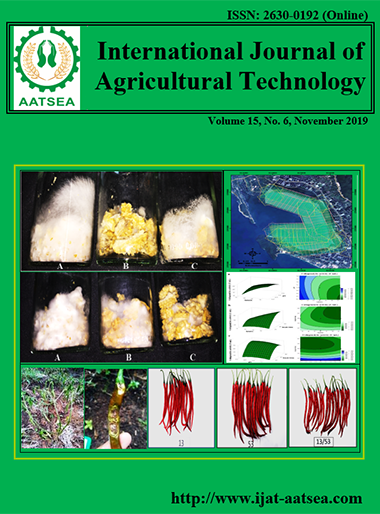Hydrolytic properties of crude protease from Bacillus subtilis subsp. subtilis M13
Main Article Content
Abstract
A new strain of Bacillus subtilis subsp. subtilis M13 which isolated from meat is proved to be the collagenase producing bacteria based on high degradation of denatured form of collagen or gelatin. The molecular weight of the crude enzyme was approximately be 21 kDa by sodium dodecyl sulfate polyacrylamide gel electrophoresis (SDS-PAGE). Maximum collagenolytic activity based on gelatin as a substrate was attained at 50°C and pH 6.0 with citrate buffer. Furthermore, this enzyme was preferable to hydrolyze insoluble collagen, and followed by elastin at 37°C and pH 6.0. Maximum hydrolysis for collagen was showed by the highest release of amino acid at 998 mg/ml after incubation for 24 h, and elastin at 656 mg/ml after incubation for 12 h. However, the hydrolytic activity against myofibrillar protein extracted from meat was relatively lower than 3.3 mg/ml at 6 h. There was found either no or slightly hydrolytic effect after prolonged incubation. The results indicated the potential protease for using as meat tenderizing enzyme with high degradation of collagen and elastin with low hydrolysis of meat myofibrillar protein.
Article Details

This work is licensed under a Creative Commons Attribution-NonCommercial-NoDerivatives 4.0 International License.
References
Baehaki, A. A., Suhartono, M. T., Sukarno, S., Syah, D., Sitanggang, A. B., Setyahadi, S. and Meinhardt, M. F. (2012). Purification and characterization of collagenase from Bacillus licheniformis F11.4. African Journal of Microbiology Research, 6:2373-2379.
Beg, Q. K. and Gupta, R. (2003). Purification and characterization of an oxidation-stable, thiol-dependent serine alkaline protease from Bacillus mojavensis. Enzyme and Microbial Technology, 32:294-304.
Bhunia, B., Basak. B. and Dey, A. (2012). A review on production of serine alkali protease by Bacillus spp. Journal of Biochemical Technology, 3:448-457.
Doddapaneni, K. K., Tatineni, R., Vellanki, R. N., Rachcha, S., Anabrolu, N., Narakuti, V. and Mangamoori, L. N. (2009). Purification and characterization of a solvent and detergent-stable novel protease from Bacillus cereus. Microbiological Research, 164:383-390.
Gerze, A., Omay, D. and Guvenilir, Y. (2005). Partial purification and characterization of protease enzyme from Bacillus subtilis megatherium. Applied Biochemistry and Biotechnology, 121:335-345.
Ha, M., Bekhit A. E. D, Carne, A. and Hopkins, D. L. (2013). Comparison of the proteolytic activities of new commercially available bacterial and fungal proteases toward meat proteins. Journal of Food Science, 78:C170-7.
Haddar, A., Bougatef, A., Agrebi, R., Sellami-Kamoun, A. and Nasri, M. (2009). A novel surfactant-stable alkaline serine-protease from a newly isolated Bacillus mojavensis A21. Purification and characterization. Process Biochemistry, 44:29-35.
Kumar, C. G. and Takagi, H. (1999). Microbial alkaline proteases: From a bioindustrial viewpoint. Biotechnology Advances, 17:561-594.
Laemmli, U. K. (1970). Cleavage of structural protein during the assembly the head of bacteriophage T4. Nature, 227:680-685.
Li, Q., Yi, L., Marek, P. and Iverson, B. L. (2013). Commercial proteases: present and future. FEBS letters, 587:1155-1163.
Maruthiah, T., Esakkiraj, P., Prabakaran, G., Palavesam, A. and Immanuel, G. (2013). Purification and characterization of moderately halophilic alkaline serine protease from marine Bacillus subtilis AP-MSU 6. Biocatalysis andAgricultural Biotechnology, 2:116-119.
Ningthoujam, D. S., Kshetri, P., Sanasam, S. and Nimaichand, S. (2009). Screening, identification of best producers and optimization of extracellular proteases from moderately halophilic alkalithermotolerant indigenous actinomycetes. World Applied Sciences Journal, 7:907-916.
Okamoto, M., Yonejima, Y., Tsujimoto, Y., Suzuki, Y. and Watanabe, K. (2001). A thermostable collagenolytic protease with a very large molecular mass produced by thermophilic Bacillus sp. strain MO-1 Applied Microbiology and Biotechnology, 57:103-108.
Pal, G. K. and Suresh, P. V. (2016). Microbial collagenases: Challenges and prospects in production and potential applications in food and nutrition. RSC Advances, 6:33763-33780.
Purslow, P. P. (2005). Intramuscular connective tissue and its role in meat quality. Meat Science, 70:435-447.
Rao, M. B., Tanksale, A. M., Ghatge, M. S. and Deshpande, V. V. (1998). Microbial and Biotechnological aspects of microbial protease. Microbiology and Molecular Biology Reviews, 62:597-635.
Singh, S. K., Singh, S. K., Tripathi, V. R. and Garg, S. K. (2012). Purification, characterization and secondary structure elucidation of a detergent stable, halotolerant, thermoalkaline protease from Bacillus cereus SIU1. Process Biochemistry, 47:1479-1487.
Sorapukdee, S. and Tangwatcharin, P. (2019). Collagenolytic Enzymes from Selected Bacteria and Its Potential Application in Beef Tenderization. Progress report to the Thailand ResearchFund (TRF) through Research Grant for New Scholar (MRG6180240). (unpubished data).
Souza, P. M., Bittencourt, M. L. A., Caprara, C. C., Freitas, M., Almeida, R. P. C., Silveira, D., Fonseca, Y.M., Filho, E. X. F., Junior, A. P. and Magalhães, P. O. (2015). A biotechnology perspective of fungal proteases. Brazilian Journal of Microbiology, 46:337-346.
Suphatharaprateep, W., Cheirsilp, B. and Jongjareonrak, A. (2011). Production and properties of two collagenases from bacteria and their application for collagen extraction. New Biotechnology, 28:649-655.
Takagi, H., Kondou, M., Hisatsuka, T., Nakamori, S., Tsai, Y. C. and Yamasaki, M. (1992). Effects of an alkaline elastase from an alkalophilic Bacillus strain on the tenderization of beef meat. Journal of Agricultural and Food Chemistry, 40:577-83.
Tran, K. A. and Nagano, H. (2002). Isolation and characteristics of Bacillus subtilis CN2 and its collagenase production. Journal of Food Science, 67:1184-1187.
Wu, Q., Li, C., Chen, H. and Shuliang, L. (2010). Purification and characterization of a novel collagenase from Bacillus pumilus Col-J. Applied Biochemistry and Biotechnology, 160:129-139.
Yeh, C. M., Yang, M. C. and Tsai, Y. C. (2002). Application potency of engineered G159 mutants on P1 substrate pocket of Subtilisin YaB as improved meat tenderizers. Journal of Agricultural and Food Chemistry, 50:6199-204.


